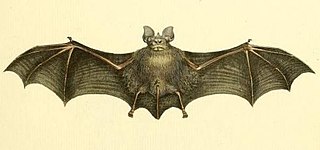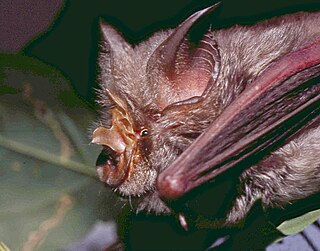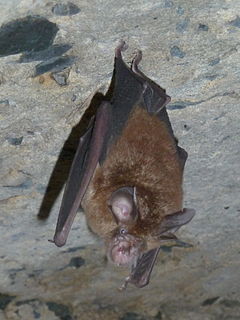
Horseshoe bats are bats in the family Rhinolophidae. In addition to the single living genus, Rhinolophus, which has about 106 species, the extinct genus Palaeonycteris has been recognized. Horseshoe bats are closely related to the Old World leaf-nosed bats, family Hipposideridae, which have sometimes been included in Rhinolophidae. The horseshoe bats are divided into six subgenera and many species groups. The most recent common ancestor of all horseshoe bats lived 34–40 million years ago, though it is unclear where the geographic roots of the family are, and attempts to determine its biogeography have been indecisive. Their taxonomy is complex, as genetic evidence shows the likely existence of many cryptic species, as well as species recognized as distinct that may have little genetic divergence from previously recognized taxa. They are found in the Old World, mostly in tropical or subtropical areas, including Africa, Asia, Europe, and Oceania.
The dark-brown serotine is a species of vesper bat found in Central and West Africa.

The intermediate horseshoe bat is a bat species of the family Rhinolophidae that is very widespread throughout much of the Indian subcontinent, southern and central China and Southeast Asia. It is listed by IUCN as Least Concern as it is considered common where it occurs, without any known major threats.

The halcyon horseshoe bat is a species of bat in the family Rhinolophidae. It is found in Cameroon, Republic of the Congo, Democratic Republic of the Congo, Ivory Coast, Equatorial Guinea, Ghana, Guinea, Kenya, Liberia, Nigeria, Senegal, South Sudan, Togo, Uganda, possibly Gabon, and possibly Sierra Leone. Its natural habitats are subtropical and tropical dry and moist lowland forest, moist savanna, caves, and other subterranean habitats.

Blasius's horseshoe bat is a species of insectivorous bat in the family Rhinolophidae found throughout large parts of the Mediterranean, Middle East and Africa.

Geoffroy's horseshoe bat is a species of bat in the family Rhinolophidae found in Africa. Its natural habitats are subtropical or tropical moist lowland forest, Mediterranean-type shrubby vegetation, caves and other subterranean habitats, and hot deserts.

The Andaman horseshoe bat is a species of bat in the family Rhinolophidae. It is endemic to the Andaman Islands. During the day, it roosts in caves, but may also choose tree hollows.

The convex horseshoe bat is a species of bat in the family Rhinolophidae. It is found in Malaysia and Laos.

Darling's horseshoe bat is a species of bat in the family Rhinolophidae found in Africa. Its natural habitats are dry savanna, caves and other subterranean habitats.

Rüppell's horseshoe bat is a species of bat in the family Rhinolophidae found in Africa. Its natural habitats are subtropical or tropical dry forests, savanna, caves and other subterranean habitats. This species is quite common in parts of its range, and no specific threats have been recognised, so the International Union for Conservation of Nature has rated its conservation status as being of "least concern".

The Guinean horseshoe bat is a species of bat in the family Rhinolophidae. It is found in Ivory Coast, Guinea, Liberia, Senegal, and Sierra Leone. Its natural habitats are subtropical and tropical forests, moist savanna, caves, and other subterranean habitats.

Rhinolophus hilli, Hill's horseshoe bat, is a species of bat in the family Rhinolophidae. It is endemic to Rwanda. Its natural habitats are subtropical or tropical moist montane forests, caves, and subterranean habitats. In 2013, Bat Conservation International listed this species as one of the 35 species of its worldwide priority list of conservation. It is threatened by habitat loss.

The Hills' horseshoe bat is a species of bat in the family Rhinolophidae. It is found in Cameroon, Guinea, Liberia, and Nigeria. Its natural habitats are subtropical and tropical moist lowland and montane forest, caves and other subterranean habitats.

Maclaud's horseshoe bat is a species of bat in the family Rhinolophidae. It is endemic to Guinea. Its natural habitats are moist savanna, caves and other subterranean habitats. It is one of five African microbat species to be listed as endangered by the IUCN. In 2013, Bat Conservation International listed this species as one of the 35 species of its worldwide priority list of conservation. It is threatened by habitat loss.

The smaller horseshoe bat is a species of bat in the family Rhinolophidae. It is found in Australia and Papua New Guinea.

The Ruwenzori horseshoe bat is a species of bat in the family Rhinolophidae. It is found in Democratic Republic of the Congo, Rwanda, and Uganda. Its natural habitats are subtropical or tropical moist lowland forest and swamps, caves and other subterranean habitats.
Bat Conservation International (BCI) is an international nongovernmental organization working to conserve bats and their habitats through conservation, education, and research efforts.
Willard's horseshoe bat is a newly described species of bat in the family Rhinolophidae. It is endemic to a small area in the Democratic Republic of the Congo. It is listed as endangered by the IUCN Red List.
The Kahuzi horseshoe bat is a species of bat in the family Rhinolophidae, which is found in eastern Democratic Republic of the Congo. It is named after Mount Kahuzi.
















